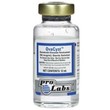Pronunciation
HYU-man ko-RI-on-ic go-nad-o-TRO-pin - Pronunciation guide
Brand Names
- OvaCyst
Description
 Harvested from the urine of pregnant women, human chorionic gonadotropin is a hormone secreted by the placenta and is used by broodmare veterinarians to induce ovulation in mares. Because HCG usually causes ovulation of a mature follicle within 36 to 48 hours, this drug allows the mare to be bred at the optimal time for conception.
Harvested from the urine of pregnant women, human chorionic gonadotropin is a hormone secreted by the placenta and is used by broodmare veterinarians to induce ovulation in mares. Because HCG usually causes ovulation of a mature follicle within 36 to 48 hours, this drug allows the mare to be bred at the optimal time for conception.
Usage
Human chorionic gonadotropin is used to time the breeding of mares to achieve optimal conception. By inducing ovulation, HCG enables broodmare veterinarians to obtain better results with fewer breeding attempts.
HCG is also used in the diagnosis of retained testicles by creating a measurable rise in testosterone in geldings exhibiting stallion-like behavior.
Dosage and Administration
 Human Chorionic Gonadotropine Human Chorionic Gonadotropine |
||||
|---|---|---|---|---|
| Method | Dosage | Concentration | Period | Duration |
| Intraveneous or Intramuscular injection | 2000-3000 IU | NA | Treatment1 | NA |
Notes:
|
||||
Side Effects
No common side effects are reported in HCG use. Injection site reactions, such as pain and swelling, are infrequent and are usually relieved by hot compresses and nonsteroidal anti-inflammatory drugs. Rare anaphylactic reactions have been reported.
Precautions
Most HCG preparations have a limited shelf life once they are reconstituted. Follow directions on label.
HCG is FDA-approved for use in cows. It is commonly used in horses and is accepted practice. HCG is a prescription drug, and U.S. federal law restricts this drug to use by or on the lawful written or oral order of a licensed veterinarian.
HCG should not be given in early pregnancy, as it may cause embryonic death.
Repeated use of HCG may cause antibody formation in the mare. Mares with high antibodies may not respond reliably to HCG.
There are no indications for HCG use in competition horses. Check with the individual regulatory group.
Interactions
None noted in literature.
Overdose
No information noted in literature.
Images
 OvaCyst Powder
OvaCyst Powder
Literature
